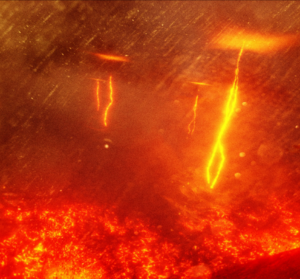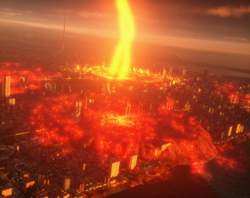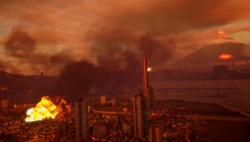Kataibatic Event: Difference between revisions
BattlerNonna (talk | contribs) mNo edit summary |
BattlerNonna (talk | contribs) mNo edit summary |
||
| Line 60: | Line 60: | ||
The '''Kataibatic Event''', also recognized by [[Eordis]]'s international scientific community '''the Kataibatic Irregular Natural Cataclysmic Event (KINCE)''', was a widespread catastrophic event incurred by the activation of the [[Kataibatic Tablet]] on 19 March 2039 during the last years of the [[Neocon War]]. The tablet's unleashing occurred during the [[Allied Anatolian Campaign]] when [[Ziyaad of the Levant|Caliph Ziyaad]] insisted on using the ancient artifact against the invading Heimdallr forces. The Tablet's power was apocalyptic, unleashing a amalgam of natural disasters that killed 450,000 around the Middle East and Southern Europa on the day it was activated. The aftereffects from its increased power would remain until 14 June 2040, all matching the descriptions inscribed in the [[Apocrypha Presbos Seleucidon|Second Kataibatic Tablet Scroll]]: unnatural storms indicated by yellow lightning, hurricanes, redding of the skies, geothermal disasters, and earthquakes after a blinding flash. By its end on the aformentioned date, the Event was regarded as one of the worst man-made and natural disasters in the history of Eordis by the number of casualties and missing. | The '''Kataibatic Event''', also recognized by [[Eordis]]'s international scientific community '''the Kataibatic Irregular Natural Cataclysmic Event (KINCE)''', was a widespread catastrophic event incurred by the activation of the [[Kataibatic Tablet]] on 19 March 2039 during the last years of the [[Neocon War]]. The tablet's unleashing occurred during the [[Allied Anatolian Campaign]] when [[Ziyaad of the Levant|Caliph Ziyaad]] insisted on using the ancient artifact against the invading Heimdallr forces. The Tablet's power was apocalyptic, unleashing a amalgam of natural disasters that killed 450,000 around the Middle East and Southern Europa on the day it was activated. The aftereffects from its increased power would remain until 14 June 2040, all matching the descriptions inscribed in the [[Apocrypha Presbos Seleucidon|Second Kataibatic Tablet Scroll]]: unnatural storms indicated by yellow lightning, hurricanes, redding of the skies, geothermal disasters, and earthquakes after a blinding flash. By its end on the aformentioned date, the Event was regarded as one of the worst man-made and natural disasters in the history of Eordis by the number of casualties and missing. | ||
The extensive proportion of the damage wrought about international shock and condemnation. In what is to be termed the "Kataibatic Effect," numerous countries in the Neoconservative Alliance, sprung into widespread revolt against the Neocon governments, and later observed the resignations of three presidents of the Neocon nations: [[Quyền Phương Nghi]], [[Khaing Zeyar Zin]] and [[Juan Martín Pareja]]. From the nations of the Heimdallr Council, their governments expressed their utmost condemnations against the Neocon governments and its citizens, alongside those of the Neocon countries, were instilled a sentiment of sadness and anger given the scale of the disaster. The tremendous psychological and emotional impact brought about by the Cataclysm and the aftermath led governments to mark the Cataclysm as a day of remembrance, which also gave rise to the shortname names | The extensive proportion of the damage wrought about international shock and condemnation. In what is to be termed the "Kataibatic Effect," numerous countries in the Neoconservative Alliance, sprung into widespread revolt against the Neocon governments, and later observed the resignations of three presidents of the Neocon nations: [[Quyền Phương Nghi]], [[Khaing Zeyar Zin]] and [[Juan Martín Pareja]]. From the nations of the Heimdallr Council, their governments expressed their utmost condemnations against the Neocon governments and its citizens, alongside those of the Neocon countries, were instilled a sentiment of sadness and anger given the scale of the disaster. The tremendous psychological and emotional impact brought about by the Cataclysm and the aftermath led governments to mark the Cataclysm as a day of remembrance, which also gave rise to the shortname names '''the Cataclysm''' and '''5/19''', and period time names "pre-" and "post-5/19," and "pre-" and "post-Cataclysm"; the cultural effects of the disaster would observe literature, film, and music focus on peactime and anti-war themes. | ||
==Background== | ==Background== | ||
| Line 66: | Line 66: | ||
==The Event== | ==The Event== | ||
===Cataclysm ( | ===Cataclysm (May 19)=== | ||
[[File:KataibaticEventOnCity.PNG|thumb|250px|right|The devastation on the Cyprian city of Salamis during the Cataclysm.]] | [[File:KataibaticEventOnCity.PNG|thumb|250px|right|The devastation on the Cyprian city of Salamis during the Cataclysm.]] | ||
Revision as of 08:28, 14 September 2022
 Snapshot of the footage of the Pergamon Wildfires and yellow lightning from the Kataibatic Storm recorded by co-pilot Kayleigh Stephenson on Concordian AWACS Tenable | |
| Date | May 19, 2039 – June 14, 2040 |
|---|---|
| Location | Middle East, Southern Europa |
| Type | Meteorologic, volcanic, earthquakes, wildfire |
| Cause | Activation of the Kataibatic Tablet |
| Deaths |
|
| Non-fatal injuries | 7,900,000 (End) |
| Missing | approx. 13,000,000 (End) |
The Kataibatic Event, also recognized by Eordis's international scientific community the Kataibatic Irregular Natural Cataclysmic Event (KINCE), was a widespread catastrophic event incurred by the activation of the Kataibatic Tablet on 19 March 2039 during the last years of the Neocon War. The tablet's unleashing occurred during the Allied Anatolian Campaign when Caliph Ziyaad insisted on using the ancient artifact against the invading Heimdallr forces. The Tablet's power was apocalyptic, unleashing a amalgam of natural disasters that killed 450,000 around the Middle East and Southern Europa on the day it was activated. The aftereffects from its increased power would remain until 14 June 2040, all matching the descriptions inscribed in the Second Kataibatic Tablet Scroll: unnatural storms indicated by yellow lightning, hurricanes, redding of the skies, geothermal disasters, and earthquakes after a blinding flash. By its end on the aformentioned date, the Event was regarded as one of the worst man-made and natural disasters in the history of Eordis by the number of casualties and missing.
The extensive proportion of the damage wrought about international shock and condemnation. In what is to be termed the "Kataibatic Effect," numerous countries in the Neoconservative Alliance, sprung into widespread revolt against the Neocon governments, and later observed the resignations of three presidents of the Neocon nations: Quyền Phương Nghi, Khaing Zeyar Zin and Juan Martín Pareja. From the nations of the Heimdallr Council, their governments expressed their utmost condemnations against the Neocon governments and its citizens, alongside those of the Neocon countries, were instilled a sentiment of sadness and anger given the scale of the disaster. The tremendous psychological and emotional impact brought about by the Cataclysm and the aftermath led governments to mark the Cataclysm as a day of remembrance, which also gave rise to the shortname names the Cataclysm and 5/19, and period time names "pre-" and "post-5/19," and "pre-" and "post-Cataclysm"; the cultural effects of the disaster would observe literature, film, and music focus on peactime and anti-war themes.

